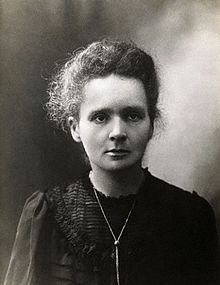This is an old revision of this page, as edited by 72.149.111.10 (talk) at 19:07, 5 February 2007 (→Biography). The present address (URL) is a permanent link to this revision, which may differ significantly from the current revision.
Revision as of 19:07, 5 February 2007 by 72.149.111.10 (talk) (→Biography)(diff) ← Previous revision | Latest revision (diff) | Newer revision → (diff)| Maria Skłodowska-Curie | |
|---|---|
 Maria Skłodowska-Curie. Maria Skłodowska-Curie. | |
| Born | November 7 1867 Warsaw, Poland |
| Died | July 4 1934 Sancellemoz, France |
| Nationality | |
| Alma mater | Sorbonne and ESPCI |
| Known for | Radioactivity |
| Awards | File:Nobel.svg Nobel Prize for Physics (1903) File:Nobel.svg Nobel Prize for Chemistry (1911) |
| Scientific career | |
| Fields | Physics and Chemistry |
| Institutions | Sorbonne |
| Doctoral advisor | Henri Becquerel |
| Doctoral students | André-Louis Debierne Marguerite Catherine Perey |
| Notes | |
| The only person to win two Nobel Prizes in different science fields. Married to Pierre Curie (m. 1895), their children include Irène Joliot-Curie and Ève Curie. | |
Maria Skłodowska-Curie (born Maria Skłodowska; known in France, where she lived most of her life, as Marie Curie, aka Madame Curie; Warsaw, November 7, 1867 – July 4 1934, Sancellemoz, France) was a Polish-French physicist and chemist. She was a pioneer in radioactivity, the first two-time Nobel laureate (the only one in two different sciences), and the first female professor at the Sorbonne.
She was born in Warsaw, Poland, to Polish parents and lived there to age 24. In 1891 she went to Paris, France, to study science. She obtained her higher degrees; and conducted nearly all her scientific work there, and became a naturalized French citizen. She founded the Curie Institutes in Paris, France, and in her home town, Warsaw, in resurrected Poland.
TTTTTTTTTTTTTTTTTYYYYYYYYYYYYYYYYYYYYLLLLLLLLLLLLLLLLEEEEEEEEEEEEEEEEERRRRRRRRRRRRRRRR SSSSSSSSSSSTTTTTTTTTTRRRRRRRRRRRRRRROOOOOOOOOOOMMMMMMMMMMMMMM
Prizes
- Nobel Prize for Physics (1903)
- Davy Medal (1903)
- Matteucci Medal (1904)
- Nobel Prize for Chemistry (1911)
Tribute
Skłodowska-Curie's younger daughter, Eve Curie, wrote the biography, Madame Curie, after her mother's death.
In 1995, Madame Curie was the first and only woman laid to rest under the famous dome of the Panthéon, in Paris, on her own merits (alongside her husband, Pierre Curie).
A unit of radioactivity, the Curie (symbol Ci), is named in their honor.
Greer Garson and Walter Pidgeon starred in the 1943 U. S. Oscar-nominated film, Madame Curie, based on her life.
"Marie Curie" appears as a character in the 1988 comedy, Young Einstein, by Yahoo Serious.
French playwright Jean-Noël Fenwick's 1989 lighthearted drama, Les Palmes de M. Schutz, is based on the early romance and scientific collaboration of Marie and Pierre Curie. A 1997 movie version starred Isabelle Hupert as Mme. Curie.
Skłodowska-Curie's likeness appeared on the Polish late-1980s inflationary 20,000-złoty banknote. Her likeness also appeared on stamps and coins, and on the last French 500-franc note (with her husband, Pierre Curie) before the franc was made obsolete by the euro.
Element no. 96, Curium (Cm), is named in honour of her and Pierre.
Pierre and Marie Curie University, the largest science, technology and medicine university in France, and successor institution to the faculty of science at the University of Paris, where she taught, is named in honor of her and Pierre. The university is home to the laboratory where they discovered radium.
A school named for her, Marie Curie M.S.158, in Bayside, New York, specializes in science and technology.
See also

- Maria Curie-Skłodowska University in Lublin
- Maria Skłodowska-Curie Institute of Oncology in Warsaw
- List of people on stamps of Ireland
- Marie Curie Cancer Care
- Curie
- List of atheists
Further reading
- Madame Curie: A Biography, by Eve Curie, ISBN 0-306-81038-7
- Marie Curie: A Life, by Susan Quinn, ISBN 0-201-88794-0
- Obsessive Genius: The Inner World of Marie Curie, by Barbara Goldsmith, ISBN 0-393-05137-4
- The Book about Blanche and Marie, by Per Olov Enquist, ISBN 1-58567-668-3, a fictionalized account of relationships among Curie, JM Charcot and Blanche Wittman
References
External links
- Out of the Shadows-A study of women physicists
- Marie and Pierre Curie and the Discovery of Polonium and Radium unabridged spinless right chronology from nobelprize.org
- 1903 Nobel Prize in Physics and 1911 Nobel Prize in Chemistry – Nobel committee page; presentation speech, her award lecture etc.
- The official web page of Maria Curie Skłodowska University in Lublin, Poland in English.
- Detailed Biography at Science in Poland website; with quotes, photographs, links etc.
- Long biography at American Institute of Physics website (site also has a short version for kids entitled "Her story in brief!")
- Maria Skłodowska-Curie Museum in Warsaw
- Marie Curie: A Nobel Prize Pioneer at the Panthéon
- European Marie Curie Fellowships
- Marie Curie Fellowship Association
- Marie Curie Cancer Care, UK
- Marie Sklodowska Curie: Her Life as a Media Compendium
- Ron Schuler's Parlour Tricks: Marie Curie
- Annotated bibliography of Marie Curie from the Alsos Digital Library
- Obituary, New York Times, July 5, 1934 Mme. Curie Is Dead; Martyr to Science
- Marie Curie on the 500 French Franc and 20000 old Polish Zloty banknotes.
- Biography resources dedicated to Marie Curie
- American Institute of Physics: Marie Curie Exhibit on the Life of Marie Curie. Marie Curie photos available from AIP
Template:Persondata
Template:Link FA
- Polish people
- French chemists
- French physicists
- Polish chemists
- Polish physicists
- Nobel laureates in Chemistry
- Nobel laureates in Physics
- Discoverers of chemical elements
- Polish Nobel Prize winners
- Radioactivity
- Women chemists
- Women physicists
- Polish atheists
- French atheists
- People from Warsaw
- Polish-French people
- People buried at the Panthéon
- 1867 births
- 1934 deaths
